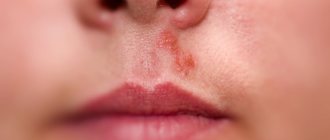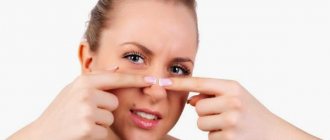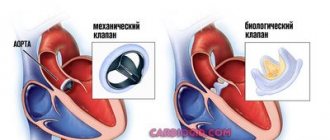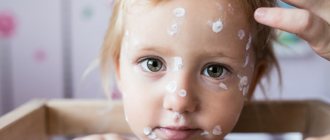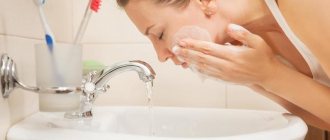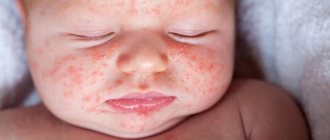"Triangle of Death" and acne
Experts do not recommend squeezing out acne on your own, and if they are located in the nasolabial area, they warn about the mortal danger of such an action.
During inflammation, the blood vessels in the affected area dilate. This is required so that leukocytes quickly reach the inflamed area. When squeezing out an acne element, we exert a mechanical force on it, risking damage to the walls of nearby vessels. Such actions are a direct path to infection. It quickly spreads, heading to the sinuses and meninges. When the latter become inflamed, meningitis develops, and when infection enters the sinuses, blood clots may appear. The formation of blood clots is explained by the fact that blood coagulates around particles from the inflamed lesion, and the neoplasm increases to such a size that it clogs the vessel.
The danger is that the venous sinuses supply the brain with blood. In the area of the nasolabial triangle there is a dense network of blood supply, so the soft tissues of the face heal relatively quickly. There are many veins, arteries, and anastomoses in this area. Veins form two networks – deep and superficial. One of the most important veins, the facial vein, is connected to the deep pterygoid venous plexus and also flows into the jugular vein, which leaves the cranial cavity and descends to the neck.
The facial vein is often involved in the process of inflammation during suppuration on the wings of the nose and upper lip. Under normal conditions, the direction of outflow of venous blood is from top to bottom to the jugular vein. But if blood clots form inside the facial vein and its tributaries, retrograde (reverse) blood flow occurs, which leads to inflammation of the sinuses and meningitis. They cannot always be diagnosed immediately, which aggravates the problem and sometimes leads to irreversible consequences.
Dermatillomania and perfectionism
The fact that people most often focus on exposed areas of the body has led researchers to believe that dermatillomania is triggered by the desire to achieve an ideal appearance (for example, to eliminate a certain “flaw”). As a result, comprehensive skin care can take on inadequate forms over time.
Ira Polevaya blogs about dermatillomania on Instagram. She has lived with the disorder for eight years and associates its appearance in adolescence with the attitudes of “ideality” that were broadcast by fashion glossy:
“When I was 10 years old, I started collecting women’s teen magazines, where all the models are presented with perfect retouched skin. So a strange attitude arose in my head: “I must have perfect skin, otherwise there is no other way.” To me, it felt like a vital commitment, like knowing how to breathe.
But at the age of 12, as luck would have it, I started getting small rashes on my face, and it knocked me off my feet. I decided to get rid of these “imperfections” on my own: I crushed them and pierced them. At the same time, I tried to treat my skin the normal way, but the sight of an unpopped pimple forced me to resort to the old “bloody methods.” This dragged on for 8 years. At 17, an exacerbation began: I picked my cheek very badly, a large pink spot remained, and I began to fear that it would always be like this. This means that I will never be able to get closer to a non-existent ideal.”
Other girls also agree with the idea that beauty culture, Instagram fetishes, lookism and other stereotypes around appearance can influence the development of dermatillomania in adolescents:
“Photoshopped photos can create the erroneous impression that everyone around you has perfect skin without flaws,” says Yulia.
But the idealized image of skin in popular culture is just the tip of the iceberg. Researchers believe that the causes of dermatillomania lie deeper and have an individual background: the special biological sensitivity of the nervous system and anxiety that arises in childhood.
How to treat acne on the nose?
For acne on the nose, the causes can be relatively harmless. Sometimes just changing your cosmetic product or stopping certain medications is an important step in controlling your rash. Is it worth the risk of popping pimples yourself?
The treatment of acne, boils, and other inflammatory elements should be handled by a specialist. A dermatologist conducts an examination, makes a diagnosis and prescribes therapy based on the severity of acne or other disease.
For acne, your doctor may prescribe topical antibiotics18. These drugs include Clindovit® gel. The main active ingredient in its composition is the antibiotic lincosamide clindamycin6. It helps reduce the colonization of propionibacteria by exhibiting antibacterial activity against a wide range of propionibacterial strains6. The drug helps reduce free fatty acids on the skin6. Clindovit® gel is recommended to be combined with azelaic acid (for example, Azelik® gel) or benzoyl peroxide; this combination helps reduce the risk of developing antibiotic resistance28.
What types of acne are there?
Natalya: Pimple is a collective concept. In acne, cavitary and non-cavitary elements can be distinguished. Non-cavitary ones are a papule, a red bump that is useless to press because there is no cavity there. At most we can squeeze out exudate - a clear inflammatory fluid - from it. And we will not get any result or any satisfaction from this. If a person sees a papule, then one must understand that it is useless to crush it.
Also, do not push the knots. In severe forms of acne, there are such deep-lying, directly dense formations. Yes, cysts, that is, cavities with pus, can mature there. But they are located in the subcutaneous fat, that is, very deep. And if we put pressure on them and injure them, then, most likely, we will only make things worse, because this purulent cavity can break into the soft tissues, and everything will go very sadly.
There is also a pustule - a small pustule with a white head.
If anything, I didn’t tell you this, but theoretically such a pimple can be squeezed out.
Here you need to arm yourself with chlorhexidine, miramistin or something non-alcoholic - so as not to injure the skin. In addition, you need to take a sterile needle and, again, without fanaticism, tangentially open the purulent head. And without pressing hard, pick it up, and with light pressure bring the pus out so that a hematoma does not form. Because a hematoma is blood that soaks into the surrounding skin. Hematomas very easily, especially after the age of 25, turn into post-acne, that is, a stagnant spot of an unpleasant purple color. It will be very difficult to get him out.
Stasya: I immediately have flashbacks before my eyes - scenes with my knots pass.
Natalya: It’s not a fact that you had a node, because nodes are markers of really severe acne. They are really large and can be up to a couple of centimeters in diameter. And there, of course, are indications for antibiotic therapy in addition to the main treatment.
Dermatillomania as a way to survive violence
Nastya Simbirskaya also writes a blog about dermatillomania, in which she openly talks about the disorder. Its first manifestations occurred at the age of 6 years. According to the girl, in 20 years of living with dermatillomania, there was not a day when she did not touch her skin.
“This happened after my stepfather beat me for the first time. From that moment on, the punishments were regular; I could only distract myself by picking at my skin. And I began to understand that this was already a disease almost 20 years later. I thought I was the only one who was crazy.”
Psychoanalysts talk most about the relationship between skin diseases and traumatic memories from childhood.
According to their observations, the psyche of an adult is capable of regressing - returning to early childhood in order to act out the trauma that occurred not through the child’s fault, but which is still preserved in his unconscious.
And the younger the child, the more physical or emotional abuse will be imprinted on him. The psyche will not record actual memories, but bodily sensations and marks on the skin will remain for life.
“Since for me it is associated with domestic violence and with all the accompanying feelings during the 12 years that I was beaten, now I feel dermatillomania as a way to get rid of obsessive thoughts, emotional swings, fears, stress and suffering. The brain knows no other way to deal with these problems. It’s more convenient for him to cause himself physical pain than to experience psychological pain,” Nastya shares.
Dermatillomania and anxiety
The American Psychiatric Association considers dermatillomania within the framework of obsessive-compulsive disorder (OCD). The term “neurotic excoriation” is used, that is, uncontrolled scratching.
The consciousness of a person with OCD is guided by a closed chain “restless thought - anxious expectation - fear - habitual ritual - relief”:
- The thought of imperfection fuels a chronic anxiety background, in which it is unbearable to constantly exist.
- A person again and again resorts to a familiar ritual, because he sees this as the only way to at least temporarily get rid of painful anxiety.
- And the usual ritual here is bodily obsession: only after exposure to the skin does the stage of temporary relief and internal satisfaction begin.
- Then discomfort inevitably increases again, dissatisfaction with the condition of the skin arises - the chain closes and everything happens again.
Manipulations lead to the desired relaxation, but not for long: anxiety subsides only for a while, and feelings of guilt and shame for one’s own “weakness” and loss of control are overwhelming.
“When you pick, you forget. Afterwards the relief will not last long. And when you look at the spotty face afterwards, you ask, “Why again?” After all, you could just not pick,” and it became sad to look at yourself in the mirror” (Ilona, 24 years old).
The girl says that she often gets hung up on negative thoughts:
“Usually this happens if I’m driven for some reason. Or after a quarrel with someone, I may feel somewhat inferior. On nerves, so to speak."
Ulyana Kardashevskaya (18 years old) also associates dermatillomania with increased anxiety:
“For me, this usually happens after a difficult day or, conversely, before some important event. You walk up to the mirror, think you’ll just look, and don’t notice how your fingers have already noticed an unevenness on the skin. I think a difficult relationship with my mother, my low self-esteem and high anxiety played a role here.”
Dermatillomania and fear of judgment
An important diagnostic criterion for dermatillomania is preoccupation with causing damage. A person experiences a mixture of negative feelings towards himself (pity, shame, disgust, disappointment) due to the fact that he has lost control. Promises that this was the last time, that this will not happen again, are often not fulfilled - and the person is ashamed of his weakness, considers himself weak-willed.
As Nastya talks about it:
“Yes, at first the process is satisfying. But as soon as your consciousness returns and you see the result of your actions, a feeling of self-loathing, pity, powerlessness, apathy not only towards yourself, but also towards everything around you arises, aggression.”
Traces of dermatillomania - wounds and scars - provoke avoidance behavior and increase feelings of shame. A person in this state may withdraw, avoid public places, and experience difficulties in his personal life, work and friendships.
“With my brain, I understand that these [inflammations and traces of them] are trifles and people don’t care at all. They saw and forgot. But my sense of comfort does not allow me to take this calmly. I feel complex, I can’t leave the house without makeup,” Nastya shares.
“I know that they DO NOT CARE about my skin, but I still get stressed and feel awkward if a stranger is close and can easily see all my “imperfections,” says Ira Polevaya.
How to squeeze out a pimple to avoid infection and avoid scars
Stage 1. Prepare everything you need
The arsenal for a safe pimple removal procedure is as follows:
- clean hands and clean skin,
- soft towels for washing,
- disposable cosmetic wipes and sponges,
- lotion containing salicylic acid or antiseptic,
- face oil or cream containing oils.
All this is necessary in order to squeeze out a pimple safely and not aggravate the situation. Feel like a mini-surgeon: to perform an operation, the field of work must be clean and your hands must be covered with gloves. Only instead of gloves you have disposable napkins.
Step 2: Cleanse the skin
It is best to squeeze out a pimple during your morning or evening beauty routine after the first stage of care - cleansing. Wash your face with your usual product, and for a better effect, use a soft towel. This washing technique was invented by Caroline Hirons, a popular British blogger and author of books on facial care. The point is to wash off all the dirt and excess sebum from your face with a damp, warm towel—you can’t achieve this effect with just water and your palms.
In this video, Caroline Hirons explains how to cleanse your skin with a towel and shows how much dirt is left behind at the end!
After washing your face, look at the pimple. The skin is steamed, and the white head with purulent contents should be clearly visible. If this is not the case, it is better to postpone the event until later and wait until it matures.
Stage 3. Squeeze the pimple and stop in time
You need to squeeze the pimple using a disposable napkin to minimize the risk of infection of the wound on your face. You need to press with your fingertips, gently and effortlessly. Place your fingers on the sides of the area of inflammation, slightly pressing the skin. There should be an angle of 90 degrees, where horizontally - your hands, vertically - a pimple with pus on top. If you don’t do this, there is a risk of squeezing the pimple, not outward, but inward.
So, you squeeze the pimple, the purulent contents come out. If you see that not everything came out, repeat the action. It is important not to overdo it: as soon as the contents turn pink, stop pressing! Don't wait for blood to appear. If you squeeze and bleed, quickly treat the pimple with chlorhexidine.
- Cosrx cleansing toner, 900 rubles - soft alcohol-free lotion with salicylic and glycolic acid in the composition. It is also useful as a remedy for comedones.
- Chlorhexidine bigluconate, 252 rubles - a convenient antiseptic in the form of an aerosol. You can spray on all wounds and cuts.
Stage 4. Treat the area with an acid or antiseptic
At this stage, you need to act quickly: moisten the facial sponge with lotion with acids. No lotion - antiseptic, for example, chlorhexidine. Both options kill bacteria, speed up wound healing, and prepare the skin for hydration.
A burning sensation when treating a pimple with an antiseptic is a good sign. This means that the product acts on the skin. Blood is flowing - press the sponge until the bleeding stops. If the pimple was large, you will have to be patient.
Step 5. Moisturize the skin
Inflamed skin needs hydration, even if it is oily. When the skin is dry, the risk of microtraumas on it increases, and the natural oily film on the skin becomes thinner. This makes it easier for germs to settle and multiply in the skin, rewarding you with worsening acne. To avoid this, moisturize your skin with cream or oil.
Not all oils are suitable for your skin
Some of them can cause allergies, so read the ingredients carefully. On the website of Paula Begun, founder of Paula's Choice, you can find a list of oils that irritate your skin.
Oil or cream will soothe the skin. Apply the product with massaging movements over the area of inflammation to improve blood flow to it. If you do this in the evening, in the morning one of two things awaits you: either the pimple will come back and you will squeeze it out completely, or the inflammation will disappear and will heal.
- Clarins Lotus facial oil, 2004 rubles - a special oil created for problematic and oily skin. Does not clog pores, moisturizes and balances sebum production.
- Acure The essentials, 560 rubles - a product based on argan oil for nourishing and radiant skin. A couple of drops are enough to spread all over your face. You can also smear it on the ends of your hair to make it look well-groomed and shiny.
Whitehead Removal
To remove such a skin problem, a specialist may offer several cleaning procedures to choose from:
- Laser coagulation (painless treatment of problem areas using a laser).
- Mechanical removal (violation of the integrity of the eel using a sterile needle, squeezing out the contents).
- Electrocoagulation (exposure to problem areas with alternating current using an electrocoagulator needle).
Treatment of such “problems” by a cosmetologist guarantees their rapid disappearance and the absence of relapses if hygiene rules are followed.
Dermatillomania and stigma
People with dermatillomania tend to deny the disorder to the last minute and attribute bodily obsession to a bad habit.
Advertising with photoshopped skin, taboo topics in the media, presenting information in such a way that it appears as if the person himself and his insufficient efforts to care for himself are to blame for imperfect skin - all this only pushes people to compulsively seek out and eradicate their “shortcomings.”
Elina Planze:
“Standards are a very narrow framework that not everyone fits into. Hence a lot of complexes, dislike and self-hatred. If a person is prone to this kind of behavior, all of the above can seriously undermine him. And in order to find relief, a person may resort to self-harm.”
Having imperfect skin is supposedly “unacceptable” from the point of view of beauty standards. Difference and dissimilarity from the person on the cover/screen/banner are unconsciously perceived as rejection in the social environment. You are different = you are a stranger. This can cause a lot of anxiety.
“I believe that the media should show different faces and bodies more often so that people do not strive for a non-existent ideal. When you see photoshopped skin, it seems that if you squeeze out a pimple, you will get the same one, but in reality you get a scar,” says Ulyana Kardashevskaya.
Dermatillomania is stigmatized, and it is shame that causes a person to remain silent and not seek help. It is difficult to explain to others (and most importantly, to oneself) why it is so difficult to control the obsessive desire to harm oneself.
Keeping the problem under wraps creates the perception that the disorder is rare. But, according to research, about 5% of people feel the need to harm their skin in one way or another, and this is one in twenty. It has been found that 3/4 of those who experience dermatillomania are women.


